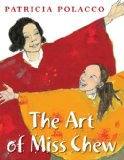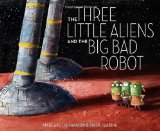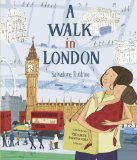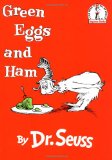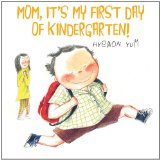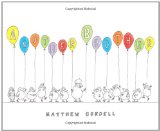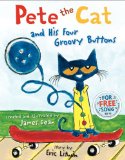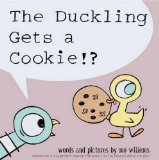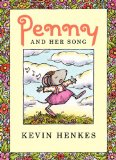I first started following Betsy Bird’s Fuse #8 blog back a few years ago, when she did the Top 100 Picture Books Poll. I didn’t start in time to contribute my votes, but I was captivated by her entertaining run down of the choices. She added web links, interesting facts, and other goodies on top of just the interesting facts of which books made the list.
I did participate in her Chapter Books poll. That time, I made the mistake of things like voting for the third Harry Potter book, since it was my favorite, and voting for The World of Pooh, because it includes both Winnie-the-Pooh and The House at Pooh Corner. No one else thought of that, so my vote went nowhere.
Now, with her much wider audience (I think), Betsy’s doing it again! But hurry — there are only a few days left! Trust me, if you don’t send in your votes, you will wish you had.
She’s running both polls again. Once again, list your top 10 favorite Picture Books, and top 10 favorite Chapter Books. They will be given 10 points for first place, 9 points for second, and so on. Yes, this is very difficult to choose. She does suggest using the first book in a series. And I’m still having a problem with the definition of “chapter book.” Some of my favorites are rather in between. But I decided that when romance is one of my favorite things about the book, like The Blue Sword, by Robin McKinley, The Goose Girl, by Shannon Hale, and The Witch of Blackbird Pond, by Elizabeth George Speare, I’d leave those books out. I also decided to go with only one book by each author, so even though I like Emily of New Moon a little better (heresy, heresy) than Anne, I went with the more well-known, partly because I do think Anne is slightly more enduring, ground-breaking, and appealing to everyone.
However, I’m going to indulge myself by listing my favorites here on my blog. I will also post these lists at my Sondy’s Selections page.
Partly, I’m posting these to force myself to commit and choose my top ten!
The Books I Consider the Top Ten Picture Books of All Time:
1. Make Way for Ducklings, by Robert McCloskey
Okay, I’m going to go with nostalgia to decide which book to put on top. I actually remember, when I was a very little girl, hearing Captain Kangaroo read this book on television. I remember the way the camera panned over the ducks almost getting hit by the cars. I was fascinated with the book, and later we checked it out from the library. Later, I bought the book and read it many times to my sons. Best of all, when we visited the Boston Public Garden when my firstborn son was two years old, we visited the statues of Mrs. Mallard, followed by Jack, Kack, Lack, Mack, Nack, Ouack, Pack, and Quack. I took a picture of my son on Mrs. Mallard’s back, then taped that sweet picture into the front of our book.
2. Bark, George, by Jules Feiffer
This was the first book my second son could read all by himself. And since then, I’ve used it in many library story times, and it always goes over well. Always. It’s got predictability, repetition, animal sounds, expressive drawings, and lovely surprising humor.
3. Doctor DeSoto, by William Steig
Sylvester and the Magic Pebble is brilliant, but in this one, William Steig uses just the right amount of words and tells a wonderfully clever tale.
4. Millions of Cats, by Wanda Gag
More nostalgia. This one, I remember reading to myself when I was very small when we would go to my great-grandmother’s house. She had some old books in her bookcase, and I know I read this one more than once. Since then, I read it to my own sons, and I still love using it in storytime. That refrain is unforgettable, and I love getting kids to chant along with me, “Hundreds of cats, thousands of cats, millions and billions and trillions of cats!”
5. The Sneetches and Other Stories, by Dr. Seuss
This book has a perfect sample of Seuss stories. The title story has social commentary. The next story, “The Zax” is a pithy tale against stubbornness. Then for perfect Seussian word play, we’ve got “Too Many Daves.” Finally, I remember that incredible shiver of fear when I read about the pale green pants with nobody inside ’em. Funny how I didn’t find that story completely hilarious until I was an adult.
6. The Three Little Wolves and the Big Bad Pig, by Eugene Trivizias, illustrated by Helen Oxenbury
I laughed and laughed when this book came in the mail from Children’s Book-of-the-Month Club. It’s a fairy tale parody perfectly carried out.
7. Don’t Let the Pigeon Drive the Bus!, by Mo Willems
I still get a big kick out of reading the temper tantrum page.
8. Chicka Chicka Boom Boom, by Bill Martin, Jr. and John Archambault, illustrated by Lois Ehlert
The best alphabet book ever. Another one that is totally fun to read aloud.
9. Are You My Mother?, by P. D. Eastman
This has everything. Different animals. A car, a plane. And all the drama and emotion of the baby bird trying to find his mother. But best of all — the Snort! I think this was one of the first books I could read. I do remember that my own mother was delighted to buy me a new book; I remember how wonderfully new and shiny it was; I remember being able to READ it; and I remember how I treasured it. [Wow. I had forgotten all this until I started writing about the book. Now that I think about it, it probably wasn’t often I got a new book of my own. That may have been why the shiny new cover made such an impression. I think it was in honor of my being able to read, or else to motivate me to be able to read it. I don’t think it was a birthday gift, but it was definitely a new book that my mother gave to me.]
Though I remember much more clearly my husband reading it to my oldest son. Josh was in his lap, so he couldn’t see his face. As the Snort lifted the baby bird and the baby bird realized something was happening, I saw Josh’s face begin to crumple. When my husband cried out, “You are not my mother! You are a Snort!” my son burst into tears. Later, when I read that to him, I tried to keep all emotion out of my voice at that part, to try to reduce the trauma.
10. Alexander and the Terrible, Horrible, No Good, Very Bad Day, by Judith Viorst
I had to include this one. It’s such a classic, all you have to say is “even in Australia” to evoke all the emotion. Truly, some days are like that. Still.
Okay, it’s getting late. So I’m going to put off my Top 10 Chapter Books until tomorrow.
